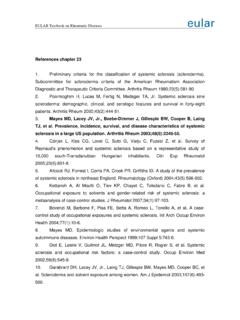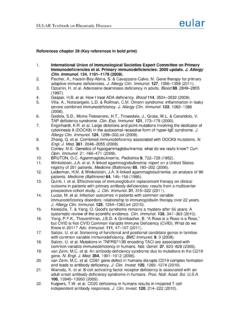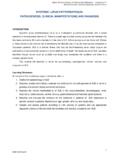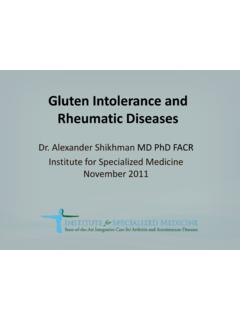Transcription of Role of Markers in the Diagnosis of Rheumatologic Diseases
1 ROLE OF LABORATORY Markers IN THE Diagnosis OF rheumatic DISEASESImad Uthman, MD, MPHP rofessor of Clinical MedicineDivision of RheumatologyAmerican University of Beirut Medical CenterIntroduction Laboratory testing in rheumatology has a major role in clinical practice. Depending on the disease suspected and antibody used, laboratory testing can play a valuable role in: screening for disease confirming diagnoses establishing disease activity determining prognosis following responses to therapyOutline Rheumatoid factor Anti-CCP ANA Anti-ds DNA Anti-Sm Anti-histone Anti-RNP Anti-SSA/SSB Anti-centromere Anti-Scl 70 APA ANCAR heumatoid Factor RF is an autoantibody that binds to the Fc region of human IgG.
2 IgM is the most common RF isotype (IgG and IgA RF may also be detected). Method of detection: latex FactorRheumatoid Factor RF is present in 75-80% of patients with rheumatoid arthritis. Positive tests occur in a wide range of autoimmune, inflammatory and chronic infections. (specificity of test for RA 80%) Prevalence also increases with age (25% of persons above the age of 65 may be positive). Titer is important: In absence of Diseases it is usually low High titer ( 1:640) almost always reflects underlying FactorRheumatic diseasesRheumatoid arthritis, systemic lupus erythematosus, scleroderma,mixed CTD Sj gren'ssyndromeViral infectionsAcquired immunodeficiency syndrome, mononucleosis, hepatitis, influenza.
3 After vaccination (may yield falsely elevated titers of antiviral antibodies)Parasitic infectionsTrypanosomiasis, kala-azar, malaria, schistosomiasis, filariasisChronic bacterial infectionsTuberculosis, leprosy, yaws, syphilis, brucellosis, subacutebacterial endocarditis, salmonellosisNeoplasmsLymphoproliferativ ediseasesOther hyperglobulinemic statesHypergammaglobulinemicpurpura, cryoglobulinemia, chronic liver disease , sarcoidosis, other chronic pulmonary diseasesDiseases commonly associated with RFRheumatoid Factor Indication: Should be ordered when there is a clinical suspicion of rheumatoid arthritis.
4 Because of the larger number of disorders associated with RF, the value of a positive test depends on the pretest probability. A negative test does not R/O rheumatoid arthritis. Up to 30% of patients are Anti-Cyclic Citrullinated Peptide (CCP) antibody Another relatively new & important marker in Diagnosis of RA. Anti-CCP antibodies have a sensitivity for RA that is similar to that of RF, but are much more specific (95% specificity).Considerable usefulness of anti-CCP antibodies in setting of: Seronegative patients suspected of having RA Patients with other forms of CTD who are RF positive Patients with hepatitis C or other infections that are often associated with RF positivity.
5 Anti-CCP Anti-CCP antibodies are often detectable in early RA. A negative test for anti-CCP does not exclude RA (at initial presentation, 50% of patients lack detectable anti-CCP antibodies). A positive anti-CCP combined with a positive RF IgM correlates strongly with radiographic progression. Anti-CCP levels are not useful in the longitudinal monitoring of disease Anti-nuclear Antibodies (ANA) are a diverse group of autoantibodies that react with antigens in the cell nucleus. Indirect immunofluorescence assays (Hep-2 cells) report the titer of ANA and pattern of staining.
6 Titer is of clinical significance (low titers can be seen in healthy individuals). Staining pattern correlates poorly with underlying disease (except centromeric pattern which is specific for limited scleroderma).ANAANAANA in different rheumatic diseasesConditionPatients with ANAs (%) Diseases for Which ANA Testing Is Helpful for DiagnosisSystemic lupus erythematosus99-100 Systemic sclerosis97 Polymyositis/dermatomyositis40-80Sj gren'ssyndrome48-96 Diseases for Which ANA Is Required for DiagnosisDrug-induced lupus100 Mixed connective tissue disease100 Autoimmune hepatitis100 Diseases for Which ANA May Be Useful for PrognosisJuvenile rheumatoid arthritis20-50 Antiphospholipidantibody syndrome40-50 Raynaud'sphenomenon20-60 ConditionPateintswithANAs (%)
7 Diseases for Which ANA Is Typically not Useful Discoid lupus erythematoissus5-25 Fibromyalgia15-25 Rheumatoid arthritis30-50 Relatives of patients with autoimmune diseases5-25 Multiple sclerosis25 ITP10-30 Thyroid disease30-50 Patients with silicone breast implants15-25 Infectious diseasesVaries widelyMalignanciesVaries widelyANA in healthy individualsNormal Individuals 1:4020-30% 1:8010-12% 1:1605% 1:3203%Significance of positive ANA depends on pretest probabilityANA-Indications for Testing When there is clinical suspicion of: SLE Drug-induced Lupus MCTD Sclerderma Sjogren Prognostic information for patients with Raynaud phenomena identifying those at risk to develop rheumatic The sensitivity of ANA for different rheumatic Diseases : SLE 95-97 % (negative ANA almost excludes Diagnosis ) Scleroderma 85 % MCTD 93 % Polymyositis/dermatomyositis 61 % Rheumatoid arthritis 41 % Rheumatoid vasculitis 33 % Sj gren's syndrome 48 % Drug-induced lupus 100 % Discoid lupus 15 % Anti-ds DNA Anti-ds DNA occur mainly in SLE.
8 They are rare in other Diseases and healthy persons (if found, titer is low). Absent in most forms of drug-induced DNA Test when there is clinical suspicion of SLE and ANA is positive. Occurs in 60-80% of SLE patients with specificity of 97%. Reflect disease activity in patients with known SLE. Level correlates with risk of developing lupus nephritis and lupus vasculitis. Anti-Sm Test when there is clinical suspicion for SLE. Occur in only 10-40% of SLE patients. Highly specific. Not useful for monitoring disease Antibody Almost always present in drug-induced lupus.
9 Also common in SLE (50-70%) Occur at low frequency in other rheumatic disorders. Absence of antibody is a strong evidence against the Diagnosis of drug-induced Test when there is clinical suspicion of MCTD. Occur in 30-40% of lupus patients . The Diagnosis of MCTD requires the presence of antibodies to of patients with MCTD have anti-RNP Not useful for monitoring disease Also known as anti Ro/anti La. Uncommon in the normal population and in rheumatic Diseases other than Sjogren and SLE. Anti-SSA present in: 75% of primary Sjogren 10-15% of RA with secondary Sjogren.
10 50% of SLE and is associated with photosensitivity, subacute cutaneous lupus, and interstitial lung disease , neonatal lupus, and congential complete heart Anti-SSB occur in almost always in association with anti-SSA. Primary Sjogren (40-50%) SLE (10-15%) Congential complete heart block (90%) Neonatal cutaneous lupus (70%)Anti-SSA/SSB Antibodies should be measured when in case of: Clinical suspicion of primary Sjogren or SLE. Suspected subacute cutaneous lupus (even with negative ANA). Mothers of children with neonatal cutaneous lupus or complete congential heart block (even if mothers are asymptomatic).








